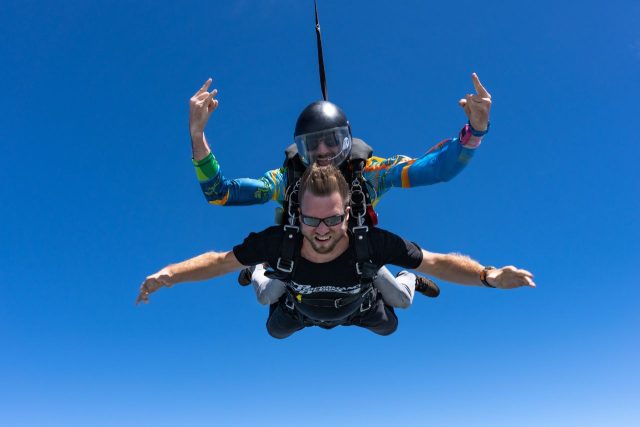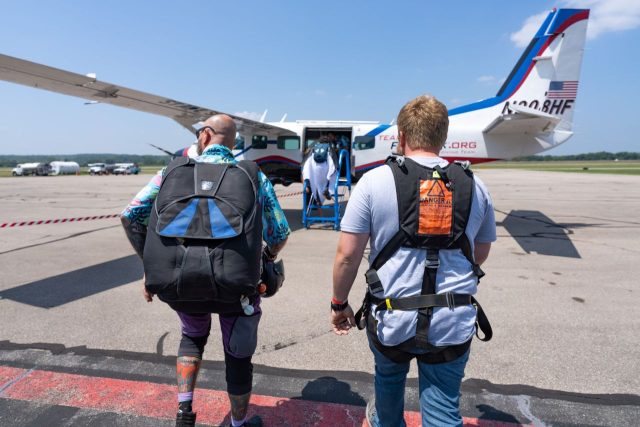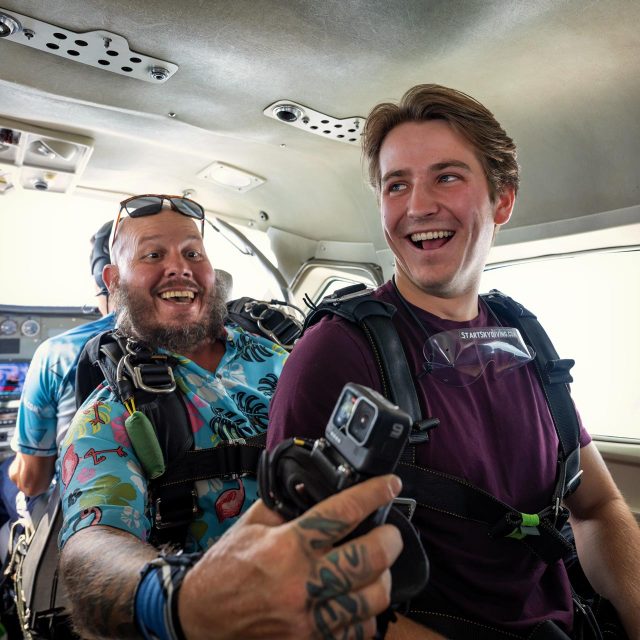Is Skydiving Safe?
Skydiving
Posted by: Start Skydiving
9 months ago
If you’re even considering going skydiving, your main focus is probably on the risks associated with jumping out of an airplane. But the good news is, skydiving is not as dangerous as you think! And Tandem skydiving is one of the safest ways to skydive, especially your first time.
Of course, accidents do happen in extreme sports. But accidents can happen anywhere. Based on statistics, skydiving is actually safer than driving in a car! Something you probably do every day. How’s that to quell your fear?
Still nervous? Fear is a completely natural reaction to doing something like falling toward the earth at 120 mph – especially if you have a fear of heights! But you can rest assured that thanks to advancements in equipment and training, the sport of skydiving is a whole lot safer than it used to be. Combine that with the safety precautions taken by dropzone owners and staff, and you’ve got a pretty good chance of having nothing but the best time of your life!

The Numbers
Let’s start with the cold hard facts. The United States Parachute Association (USPA) tracks the safety record of skydiving companies on an annual basis and reports the results publicly. There are no secrets when it comes to current (or past) incident reports, so the proof is on the page when we say that skydiving has gotten increasingly more safe over the years.
Before you take a look at the data and see for yourself, keep in mind that these stats include all jumps – so tandem jumps, student jumps, and jumps by licensed skydivers. The majority of deaths occur within the licensed skydiver community. They fly small, aggressive parachutes and sometimes licensed jumpers – oftentimes highly experienced jumpers – push their limits too far. Considering a 10 year average, there is one fatality for every 500,000 tandem jumps annually.
| Year | Skydiving Fatalities in the U.S. | Estimated Annual Jumps | Fatalities Per 100,000 Jumps |
| 2022 | 20 | 3.9 million | 0.51 |
| 2017 | 24 | 3.2 million | 0.75 |
| 2012 | 19 | 3.1 million | 0.61 |
| 2007 | 18 | 2.5 million | 0.72 |
| 2002 | 33 | 2.6 million | 1.27 |
Comparing data in five-year increments from the last 20 years, the number of annual jumps has consistently increased and the number of fatalities has decreased.
Training
Becoming a skydiver requires an immense amount of training. And becoming an instructor demands even more commitment. By the time a skydiver reaches the level of strapping a first-time jumper to their body and leaving an airplane, they’ve gained extensive knowledge and experience.
Instructor qualifications are no joke. As per the USPA, the requirements to become a certified skydiving instructor are as follows:
- Logging at least 500 jumps
- Earning a USPA D license
- Accruing a minimum of 3 years experience in the sport
- Possessing a current FAA Class III Flight Medical Certificate
- Completing the USPA tandem instructor rating certification program
Bonus: Some instructor roles even require a certain amount of time spent in freefall.
But training isn’t just for the pros. Every single skydiver, whether they have 10 jumps to 10,010 jumps, is constantly practicing and learning. And not just the fun stuff. Some of the most important training focuses on what to do in the event of something going wrong.
Emergency procedures are consistent across every experience level and skydiving destination. No matter who or where you are, you learn the same procedure for dealing with problems in the sky. That consistency means that teaching techniques are clear, successful application can be easily measured, and improvements can be made across the board.
It’s important to note that this standard of training didn’t just happen overnight. Skydiving has been around for more than half a century, and that time has allowed the culture to grow. As a community, we’ve been focused on learning from our mistakes and improving our approach over the many years we’ve been falling through the sky.

Equipment
If you think safety and training have come a long way in the last 50 years, wait until you hear about the equipment! The parachutes that skydivers are jumping nowadays are on the cutting edge of research and development. New technology is being introduced all the time, with both safety and performance in mind.
For comparison, the stuff skydivers used to jump in the old days was often referred to as “gutter gear.” We probably don’t have to tell you this, but that’s not exactly the kind of thing you want to bet your life on.
In the early days, there was no industry specifically dedicated to sport skydiving like there is today. So jumpers got their gear from the only place they could: military surplus. Some of them would even make DIY adjustments to the gear, like cutting holes in the parachutes to alter the performance. (Yikes!)
All we have to say about that is thank you to those who did it so we don’t have to! Because of the experimentation of those early jumpers (with their lives!), the equipment we jump today is the most advanced and safest gear possible.
Innovation has been so rapid and the demand so significant that skydiving gear manufacturers are now an independent industry, competing for the top spot when it comes to safety, performance, and, let’s be honest, looking cool.

Regulations
Not every safety decision is left up to skydivers themselves. The sport is governed by the USPA, which encourages some cohesion when it comes to acceptable safety practices. Every dropzone must commit to the Group Member Pledge in order to be a USPA affiliated dropzone.
The regulations set out by the organization include guidance on student jumps, licensing progression, instructor requirements, and jumping (or not jumping) in different weather conditions. And just like the other parts of skydiving, these regulations are evolving all the time.
The USPA is made up of a board of directors who are voted into their position and make decisions with every skydiver’s best interest in mind. Just like the rest of us, they learn and grow and react to the constantly changing conditions of the sport.
There’s also the element of legal liability when it comes to skydiving. Not only do USPA member dropzones follow every regulation to mitigate legal risk, they also require all students and skydivers to be the age of legal majority and to sign a waiver. If you can’t legally sign a contract, you can’t jump out of an airplane. This ensures that every person who makes a skydive is truly able to decide for themselves if the risk is worth the reward.
If skydiving is worth it to you, come jump with us – there’s nothing on this planet as life-changing as human flight!!



